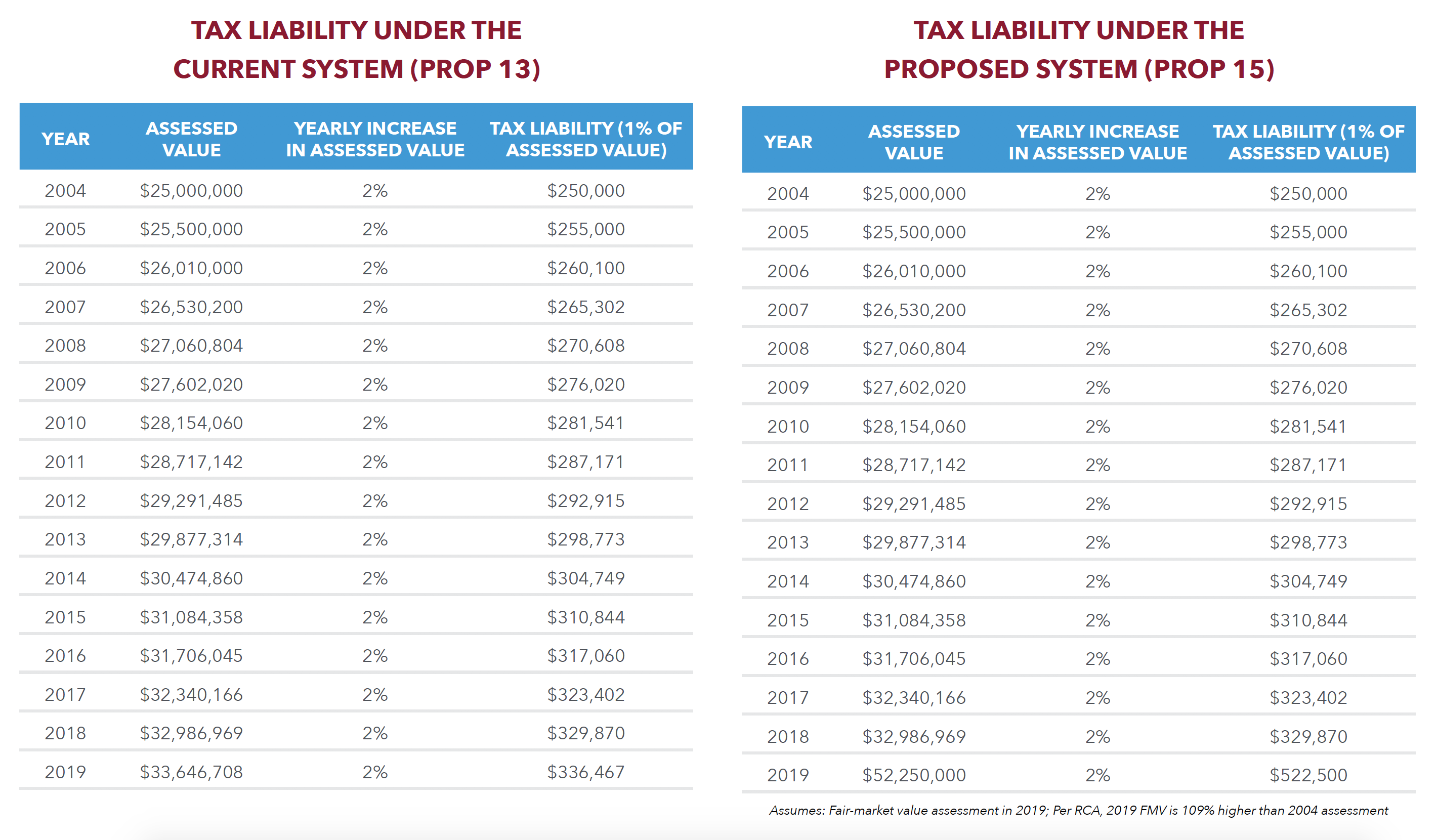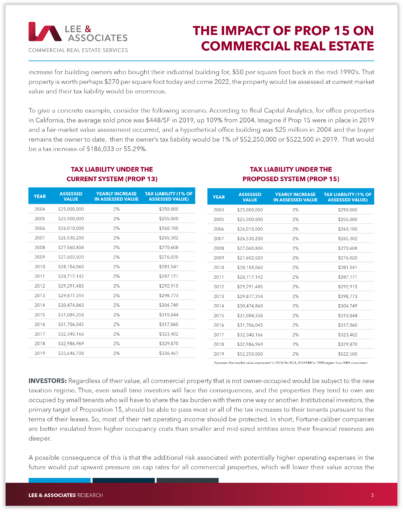On November 3, 2020, Californians will decide the fate of Proposition 15. Prop. 15, also known as the Tax on Commercial and Industrial Properties for Educational and Local Government Funding Initiative, asks voters to approve an amendment to the Constitution requiring commercial and industrial businesses to be taxed at market value rather than at purchase price. The market value of properties will be reassessed every three years beginning in fiscal year 2022-2023. This report will identify the historical background of this ballot measure, state who are its backers and detractors, state the likely consequences on the proposition were it to pass, and conclude with an assessment and recommendation regarding the proposition.
INITIATIVE OVERVIEW
Where can I read the text of the initiative?
Because of its length, the exact text of the proposition cannot be reprinted within this report, but it can be accessed and read here.
Who are the supporters of Prop 15?
The Yes on 15 campaign is funded by the California Teachers Association and has the support of the San Jose and San Bernardino Teachers Association, the League of Women Voters, healthcare professionals, other labor organizations, as well as a bevy of city, county and state officials. The full list of its supporters can be read here.
Who are the Opponents of Prop 15?
Opponents to Prop. 15 include California Farm Bureau Federation, California Hispanic Chambers of Commerce, California Small Business Association, Black Business Association, other business groups, as well as a bevy of city, county, and state officials. The full list of its opponents can be read here.
WHAT WILL PROP 15 DO IF PASSED?
To comprehend how Prop 15 will amend California’s tax code, it is important to understand the history and origins of California’s current property tax system.
Between 1974-1978, state property taxes skyrocketed by 120%. Outraged by this, voters in California enacted Proposition 13 in 1978 to check Sacramento’s power to increase property taxes. For both residential and commercial properties, Prop 13 limited one’s annual property tax liability to just one percent of the purchase price of either your residential or commercial asset. Moreover, rather than reassessing the value of either the residential or commercial property at market value, assessors were required to assume that the property annually increased in value by either two percent or the rate of inflation, whichever was lower.
One consequence of the Prop-13-tax-system is that Californians who hold their property for a long time pay far less in taxes than new buyers, with the only exceptions being new construction on a site, which resets the assessed value when a new building delivers or a decline in value associated with 1978’s Proposition 8.
Prop 15 supporters find this consequence irrational since it leaves taxable money on the table, and unfair because the tax burden is not evenly distributed. Proponents of Prop 15, as a result, propose to do three things. First, tax commercial assets at 1 percent of their fair market value, with reassessments occurring every three years. Second, agricultural buildings and owners of commercial and industrial properties with a combined value of $3.0 million or less would be exempt. And third, homeowners will continue to pay the one percent of purchase price with two percent annual caps under the current Prop 13-created-system. Because Prop 15 supporters propose to divide or split how commercial and residential buildings are taxed, it is often called “the split-roll” initiative since it splits California’s property tax roll.
The Prop 15 reform will increase state tax revenue by $8.0 to $12.5 billion per year. Once administrative costs are covered (ranging from $500 million to $800 million), 40.0% of the revenue will go to public schools and community colleges, while local governments will collect the remaining 60%. For the city of San Jose and the county of Santa Clara, for example, Prop 15 would generate an estimated $77 million and $265 million in tax revenue, respectively.
If the measure passes, the tax liability of commercial properties would be assessed at market value starting in the fiscal year 2022-2023. Properties, such as retail centers, whose occupants are 50% or more small businesses would be taxed based on market value beginning in fiscal year 2025- 2026, or at a later date depending on the legislature.
The Yes on 15 campaign uses Walt Disney Studios as an example for how the initiative could level the playing field and restore money to local communities. The Walt Disney property in Burbank spans 43 acres that was assessed in 1975. Disney pays $5 per square foot while Burbank Studios pays $180. If Disney and Burbank Studios were reassessed and taxed at current market value, they would be competing on the same plane and paying $3.5 million more in taxes each year.
WHAT CONSEQUENCE WOULD LIKELY ENSUE FROM PROP 15?
Appraisal Industry: Since Prop 15 mandates assessments every three years, this will create increased-demand for the appraisal industry.
Tenants: Increasing taxes for commercial property owners will lead to higher rents for tenants, which drives up the cost for businesses to operate in California. Small businesses, which employ nearly half of all employees in California, will likely consider out-of-state relocations.
Almost all commercial property leases in all product types contain some kind of clause that requires the tenant to pay all or a portion of property taxes for the space they occupy in addition to base monthly rent. In a net lease, the tenant pays it all from day one. In a typical gross lease, taxes for the “base year” are included in the rental rate with increases for subsequent years passed along to the tenant. But, even in a gross lease the burden is on the tenant because the base rental rate is higher to cover the landlord’s base year levy. As a result, a tenant who occupies a building with a low property tax basis could likely see his or her tax bill double, triple or even quadruple depending on when the landlord acquired the property.
Owner/Users: Because owner/users are both landlord and tenant, it is not possible to avoid a part of the tax increase. In an arms-length transaction, the parties could negotiate who has responsibility for taxes dependent on market conditions. The owner/user cannot.
Typically, owner/users hold a property for much longer than the typical duration of a lease. They do so to fix occupancy cost over the long term by obtaining fixed rate financing and staying in place as long as possible. Generally, those who choose the owner/user route can use the acquired property for 10 years or longer. Thus, imagine the property tax increase for building owners who bought their industrial building for, $50 per square foot back in the mid-1990’s. That property is worth perhaps $270 per square foot today and come 2022, the property would be assessed at current market value and their tax liability would be enormous.
To give a concrete example, consider the following scenario. According to Real Capital Analytics, for office properties in California, the average sold price was $448/SF in 2019, up 109% from 2004. Imagine if Prop 15 were in place in 2019 and a fair-market value assessment occurred, and a hypothetical office building was $25 million in 2004 and the buyer remains the owner to date, then the owner’s tax liability would be 1% of $52,250,000 or $522,500 in 2019. That would be a tax increase of $186,033 or 55.29%.

Investors: Regardless of their value, all commercial property that is not owner-occupied would be subject to the new taxation regime. Thus, even small time investors will face the consequences, and the properties they tend to own are occupied by small tenants who will have to share the tax burden with them one way or another. Institutional investors, the primary target of Proposition 15, should be able to pass most or all of the tax increases to their tenants pursuant to the terms of their leases. So, most of their net operating income should be protected. In short, Fortune-caliber companies are better insulated from higher occupancy costs than smaller and mid-sized entities since their financial reserves are deeper.
A possible consequence of this is that the additional risk associated with potentially higher operating expenses in the future would put upward pressure on cap rates for all commercial properties, which will lower their value across the board. A 1% increase in cap rates (from today’s average of 5%) would wipe out 20% of the current value of commercial properties.
Moreover, for investors weighing multiple state options, such as where to locate a business or where to develop commercial projects, California’s variable tax rates will cause them to think twice before deciding to do business in the Golden State.
EVALUATION
As our foregoing analysis makes clear, Prop 15 would be an extremely burdensome revision of the tax code. It would materially harm tenants, owners, real estate investors, and further undermine the ability of striving entrepreneurs to thrive in California. Contrary to the intentions of its proponents, Prop 15 will only entrench the position of already-powerful companies and undermine the standing of small and midsize firms. Whereas the bigger firms would be able to bear the new tax liability, the smaller firms would not. Although California’s tax code is badly in need of reform, Prop 15 isn’t it. It is neither wise nor sound.




